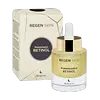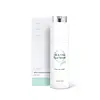What's inside
What's inside
 Key Ingredients
Key Ingredients

 Benefits
Benefits

 Concerns
Concerns

 Ingredients Side-by-side
Ingredients Side-by-side

Water
Skin ConditioningOlive Oil PEG-8 Esters
EmollientPropanediol
SolventPEG-8 Caprylic/Capric Glycerides
EmulsifyingPropylene Glycol
HumectantBakuchiol
AntimicrobialPolysorbate 20
EmulsifyingRetinol
Skin ConditioningRetinyl Palmitate
Skin ConditioningTocopheryl Acetate
AntioxidantTocopherol
AntioxidantOligopeptide-1
Skin ConditioningButylene Glycol
HumectantPolyacrylate Crosspolymer-6
Emulsion StabilisingCopernicia Cerifera Cera
EmollientXanthan Gum
EmulsifyingGlycerin
HumectantParfum
MaskingSodium Cocoamphoacetate
Cleansing1,2-Hexanediol
Skin ConditioningCaprylyl Glycol
EmollientBHT
AntioxidantBHA
AntioxidantCitric Acid
BufferingTetrasodium Glutamate Diacetate
T-Butyl Alcohol
PerfumingWater, Olive Oil PEG-8 Esters, Propanediol, PEG-8 Caprylic/Capric Glycerides, Propylene Glycol, Bakuchiol, Polysorbate 20, Retinol, Retinyl Palmitate, Tocopheryl Acetate, Tocopherol, Oligopeptide-1, Butylene Glycol, Polyacrylate Crosspolymer-6, Copernicia Cerifera Cera, Xanthan Gum, Glycerin, Parfum, Sodium Cocoamphoacetate, 1,2-Hexanediol, Caprylyl Glycol, BHT, BHA, Citric Acid, Tetrasodium Glutamate Diacetate, T-Butyl Alcohol
Water
Skin ConditioningAcetyl Hexapeptide-8
HumectantBoswellia Serrata Resin Extract
SmoothingGlycerin
HumectantCaprylic/Capric Triglyceride
MaskingPropanediol
SolventSodium Hydroxide
BufferingMaltodextrin
AbsorbentSucrose Dilaurate
EmollientSodium Cocoyl Glutamate
CleansingPisum Sativum Extract
Skin ConditioningArtemisia Umbelliformis Extract
Skin ConditioningSodium Acrylates Copolymer
Lecithin
EmollientNiacinamide
Smoothing1,2-Hexanediol
Skin ConditioningCaprylyl Glycol
EmollientTropolone
Skin ConditioningRetinol
Skin ConditioningBHT
AntioxidantRetinyl Palmitate
Skin ConditioningGlycine Soja Oil
EmollientTocopherol
AntioxidantBakuchiol
AntimicrobialGlyceryl Oleate Citrate
EmulsifyingLactic Acid
BufferingGanoderma Lucidum Extract
Skin ProtectingCamellia Sinensis Leaf Extract
AntimicrobialPolyacrylate-13
Polyisobutene
Polysorbate 20
EmulsifyingTocopheryl Acetate
Antioxidant3-O-Ethyl Ascorbic Acid
Skin ConditioningPentaerythrityl Tetra-Di-T-Butyl Hydroxyhydrocinnamate
AntioxidantFerulic Acid
AntimicrobialMandelic Acid
AntimicrobialGinkgo Biloba Leaf Extract
Skin ConditioningTerminalia Ferdinandiana Fruit Extract
AntioxidantWater, Acetyl Hexapeptide-8, Boswellia Serrata Resin Extract, Glycerin, Caprylic/Capric Triglyceride, Propanediol, Sodium Hydroxide, Maltodextrin, Sucrose Dilaurate, Sodium Cocoyl Glutamate, Pisum Sativum Extract, Artemisia Umbelliformis Extract, Sodium Acrylates Copolymer, Lecithin, Niacinamide, 1,2-Hexanediol, Caprylyl Glycol, Tropolone, Retinol, BHT, Retinyl Palmitate, Glycine Soja Oil, Tocopherol, Bakuchiol, Glyceryl Oleate Citrate, Lactic Acid, Ganoderma Lucidum Extract, Camellia Sinensis Leaf Extract, Polyacrylate-13, Polyisobutene, Polysorbate 20, Tocopheryl Acetate, 3-O-Ethyl Ascorbic Acid, Pentaerythrityl Tetra-Di-T-Butyl Hydroxyhydrocinnamate, Ferulic Acid, Mandelic Acid, Ginkgo Biloba Leaf Extract, Terminalia Ferdinandiana Fruit Extract
Ingredients Explained
These ingredients are found in both products.
Ingredients higher up in an ingredient list are typically present in a larger amount.
1,2-Hexanediol is a synthetic liquid and another multi-functional powerhouse.
It is a:
- Humectant, drawing moisture into the skin
- Emollient, helping to soften skin
- Solvent, dispersing and stabilizing formulas
- Preservative booster, enhancing the antimicrobial activity of other preservatives
Bakuchiol is a plant-derived antioxidant (it's vegan!). It is often called the replacement for retinol although it is not part of the same family.
It has similar effects as retinol: skin smoothing, reducing discoloration, and preventing wrinkles. It does not cause as much irritation as traditional retinoids.
Bakuchiol works by breaking down free radicals and stimulating collagen production in skin.
Combining bakuchiol with retinol will not have adverse side effects. Studies show using them will just boost the benefits. Bakuchiol is also found to help stabilize retinol.
While bakuchiol does not make the skin more sun sensitive, we recommend wearing SPF on a daily basis.
Read more about traditional retinol
Learn more about BakuchiolBHT is a synthetic antioxidant and preservative.
As an antioxidant, it helps your body fight off free-radicals. Free-radicals are molecules that may damage your skin cells.
As a preservative, it is used to stabilize products and prevent them from degrading. Specifically, BHT prevents degradation from oxidation.
The concerns related to BHT come from oral studies; this ingredient is currently allowed for use by both the FDA and EU.
However, it was recently restricted for use in the UK as of April 2024.
Learn more about BHTCaprylyl Glycol is a humectant and emollient, meaning it attracts and preserves moisture.
It is a common ingredient in many products, especially those designed to hydrate skin. The primary benefits are retaining moisture, skin softening, and promoting a healthy skin barrier.
Though Caprylyl Glycol is an alcohol derived from fatty acids, it is not the kind that can dry out skin.
This ingredient is also used as a preservative to extend the life of products. It has slight antimicrobial properties.
Learn more about Caprylyl GlycolGlycerin is already naturally found in your skin. It helps moisturize and protect your skin.
A study from 2016 found glycerin to be more effective as a humectant than AHAs and hyaluronic acid.
As a humectant, it helps the skin stay hydrated by pulling moisture to your skin. The low molecular weight of glycerin allows it to pull moisture into the deeper layers of your skin.
Hydrated skin improves your skin barrier; Your skin barrier helps protect against irritants and bacteria.
Glycerin has also been found to have antimicrobial and antiviral properties. Due to these properties, glycerin is often used in wound and burn treatments.
In cosmetics, glycerin is usually derived from plants such as soybean or palm. However, it can also be sourced from animals, such as tallow or animal fat.
This ingredient is organic, colorless, odorless, and non-toxic.
Glycerin is the name for this ingredient in American English. British English uses Glycerol/Glycerine.
Learn more about GlycerinPolysorbate 20 is made by combining ethoxylation of sorbitan, ethylene oxide, and lauric acid. It is a mild cleansing agent, surfactant, and emulsifier.
As a surfactant, it helps collect dirt and oils for washing. Emulsifiers prevent oils and water from separating.
Polysorbate 20 also adds scent to a product. Since it is made using sorbitol, it has a sweet scent. Sorbitol can also be found in fruits such as apples and peaches.
The lauric acid used to create Polysorbate 20 is often derived from coconuts.
Polysorbate 20 may not be fungal acne safe.
Learn more about Polysorbate 20Propanediol is an all-star ingredient. It softens, hydrates, and smooths the skin.
It’s often used to:
Propanediol is not likely to cause sensitivity and considered safe to use. It is derived from corn or petroleum with a clear color and no scent.
Learn more about PropanediolRetinol is a gold-standard ingredient for anti-aging. It is a form of Vitamin A and belongs to the class of retinoids that also includes tretinoin.
Why is retinol famous?
It has the most scientific studies backing up its skin benefits out of all the non-prescription ingredients.
Retinol is proven to:
This is why retinol is effective at removing wrinkles, fading dark spots, treating acne, and reducing the appearance of pores.
Studies show retinol is less effective when exposed to UV. Be sure to look for appropriate packaging to keep your retinol potent (similar to Vitamin C).
Using retinol or any retinoids will increase sun-sensitivity in the first few months. Though studies show retinoids increase your skin's natural SPF with continuous use, it is best to always wear sunscreen and sun-protection.
We recommend speaking with a medical professional about using this ingredient during pregnancy.
Retinol may cause irritation in some people, so be sure to patch test. Experts recommend 'ramping up' retinol use: start using this ingredient once a week and work up to using it daily.
Read about Tretinoin
Learn more about RetinolRetinyl palmitate is a form of retinoid. Retinoids are the superstar class of anti-aging ingredients that include tretinoin and retinol.
This particular ingredient has had a bumpy year with its rise and fall in popularity.
First, Retinyl palmitate is created from palmitic acid and retinol. It is a retinol ester and considered one of the weaker forms of retinoid.
This is because all retinoids have to be converted to Tretinoin, AKA retinoic acid. Retinyl Palmitate is pretty far down the line and has to go through multiple conversions before its effects are seen.
Due to this long and ineffective conversion line, the benefits of Retinyl Palmitate are debated.
Studies show Retinyl Palmitate to help:
Dermatologists say this ingredient is ineffective because it isn't used in high enough concentrations in cosmetics.
This ingredient used to be found in sunscreens to boost the efficacy of sunscreen filters.
The downfall of Retinyl Palmitate was due to released reports about the ingredient being correlated to sun damage and skin tumors.
While there is a study showing this ingredient to cause DNA damage when exposed to UV-A, there is no concrete proof of it being linked to skin cancer. It is safe to use when used correctly.
All retinoids increase your skin's sensitivity to the sun in the first few months of usage. Be especially careful with reapplying sunscreen when using any form of retinoid.
Currently, this ingredient is still allowed in cosmetics all over the world. In Canada, cosmetics must have a warning label stating the product to contain Retinyl Palmitate
Fun fact: This ingredient is often added to low-fat milk to increase the levels of Vitamin A.
Learn more about Retinyl PalmitateTocopherol (also known as Vitamin E) is a common antioxidant used to help protect the skin from free-radicals and strengthen the skin barrier. It's also fat soluble - this means our skin is great at absorbing it.
Vitamin E also helps keep your natural skin lipids healthy. Your lipid skin barrier naturally consists of lipids, ceramides, and fatty acids. Vitamin E offers extra protection for your skin’s lipid barrier, keeping your skin healthy and nourished.
Another benefit is a bit of UV protection. Vitamin E helps reduce the damage caused by UVB rays. (It should not replace your sunscreen). Combining it with Vitamin C can decrease sunburned cells and hyperpigmentation after UV exposure.
You might have noticed Vitamin E + C often paired together. This is because it is great at stabilizing Vitamin C. Using the two together helps increase the effectiveness of both ingredients.
There are often claims that Vitamin E can reduce/prevent scarring, but these claims haven't been confirmed by scientific research.
Learn more about TocopherolTocopheryl Acetate is AKA Vitamin E. It is an antioxidant and protects your skin from free radicals. Free radicals damage the skin by breaking down collagen.
One study found using Tocopheryl Acetate with Vitamin C decreased the number of sunburned cells.
Tocopheryl Acetate is commonly found in both skincare and dietary supplements.
Learn more about Tocopheryl AcetateWater. It's the most common cosmetic ingredient of all. You'll usually see it at the top of ingredient lists, meaning that it makes up the largest part of the product.
So why is it so popular? Water most often acts as a solvent - this means that it helps dissolve other ingredients into the formulation.
You'll also recognize water as that liquid we all need to stay alive. If you see this, drink a glass of water. Stay hydrated!
Learn more about Water